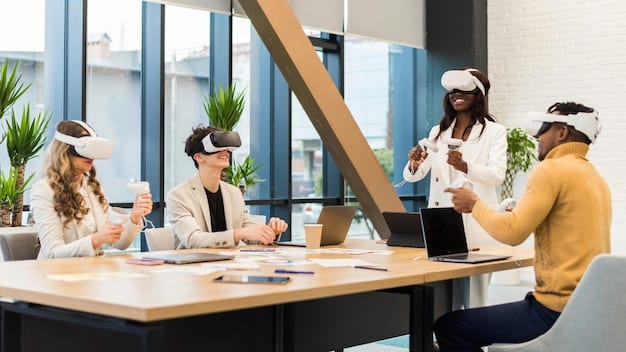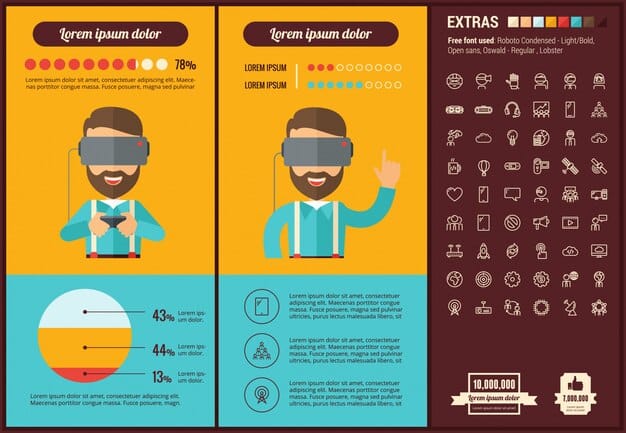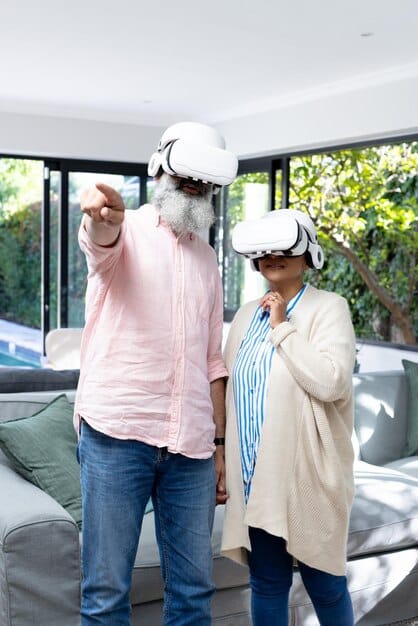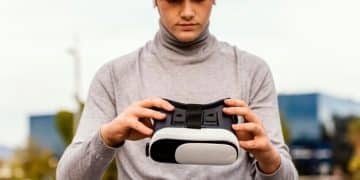VR Hardware Guide: Choosing the Right Headset for US Businesses in 2025

Navigating the VR hardware landscape to select the right VR headset can be crucial for US businesses in 2025, requiring a deep understanding of specifications, use cases, and compatibility to maximize ROI.
Choosing the right VR headset can be crucial for US businesses aiming to leverage the power of virtual reality. Our VR Hardware Guide: Choosing the Right VR Headset for Your US Business Needs in 2025 dives into the essential factors, helping you make an informed decision.
Understanding the VR Landscape for US Businesses in 2025
As 2025 approaches, virtual reality is poised to transform various sectors within the US business landscape. From training and development to remote collaboration and customer engagement, VR applications are becoming increasingly prevalent.
Choosing the right hardware is pivotal. Understanding the VR landscape helps businesses align their technology investments with practical applications and long-term strategic goals.
The Growing Adoption of VR in US Industries
Several US industries are already seeing substantial benefits from VR adoption. Healthcare utilizes VR for surgical simulations and patient rehabilitation, while the education sector employs it for immersive learning experiences. The manufacturing and engineering industries leverage VR for design visualization and remote assistance.
- Healthcare: VR simulations improve surgical training and patient care.
- Education: Immersive VR experiences enhance learning outcomes.
- Manufacturing: VR aids in design visualization and remote support.
The impact of VR extends across sectors, demonstrating its versatility and potential to enhance operations, improve efficiency, and drive innovation.
Key Considerations for VR Integration
Integrating VR into a business strategy requires careful evaluation of several factors. These include the specific use cases, the target audience, budgetary constraints, and the technical infrastructure available.
Prioritizing these considerations helps businesses to maximize the investment in VR technology by ensuring that VR solutions are not only cutting-edge but also practical and aligned with organizational goals.
Businesses that strategically approach VR adoption are more likely to realize tangible benefits and gain a competitive edge in their respective markets.
In conclusion, the growing adoption of VR in US industries necessitates a strategic approach. By understanding the VR landscape and key considerations, businesses can effectively integrate VR to drive innovation and achieve competitive advantages.
Assessing Your Business Needs for VR
Before investing in VR hardware, businesses must carefully assess their specific needs. This involves defining the objectives, identifying the target audience, and determining the practical applications of VR technology within the organization.
A thorough assessment ensures that the selected VR headsets align with the business’s operational requirements and strategic goals.

Defining Objectives and Use Cases
The first step in assessing business needs is to define clear objectives. What problems are you trying to solve, and how can VR provide a solution?
Common use cases include employee training, product design, customer engagement, and remote collaboration. Each brings unique requirements for VR hardware.
For example, high-resolution headsets might be necessary for detailed design work, while more affordable options could suffice for basic training simulations.
Identifying the Target Audience and User Requirements
Understanding who will be using the VR headsets is crucial. Different users may have different needs in terms of comfort, accessibility, and ease of use.
Factors such as the users’ technical proficiency, physical requirements, and sensitivity to motion sickness should be taken into account.
- Comfort: Headset ergonomics and weight distribution.
- Accessibility: Adjustability for different head sizes and vision needs.
- Ease of Use: Intuitive interfaces and minimal setup.
Considering these factors ensures a positive user experience, which is essential for successful VR adoption.
In summary, assessing your business needs for VR involves defining objectives, identifying the target audience, and understanding user requirements. This comprehensive approach ensures that the selected VR hardware aligns with your business’s goals and operational needs.
Top VR Headset Options for US Businesses in 2025
As we move closer to 2025, several VR headsets stand out as top contenders for business use. These headsets offer a range of features, specifications, and price points, making them suitable for various applications and budgets.
This section highlights some of the leading VR headset options for US businesses in 2025, providing an overview of their strengths and weaknesses.
High-End VR Headsets
High-end VR headsets offer the best possible visual fidelity and performance. They are ideal for applications that require detailed graphics, precise tracking, and immersive experiences.
Examples include the Varjo Aero and the HP Reverb G2. These headsets typically require powerful PCs to deliver their full potential.
Choosing a high-end headset involves assessing the trade-off between performance and cost, ensuring the investment aligns with the requirements of the VR application.
Standalone VR Headsets
Standalone VR headsets offer the convenience of wireless operation and portability. They don’t require a PC connection, making them suitable for training, presentations, and experiences that require mobility.
The Meta Quest 3 and HTC Vive Focus 3 are popular standalone options. These headsets include onboard processing power and storage, streamlining the VR experience.
- Meta Quest 3: An affordable and versatile standalone VR solution.
- HTC Vive Focus 3: A high-performance standalone headset for business use.
The versatility of standalone headsets makes them an appealing choice for businesses looking to implement VR across diverse scenarios.
Tethered VR Headsets
Tethered VR headsets, such as the Valve Index, connect to a PC via a cable. This connection enables higher performance and more complex VR experiences but limits the user’s mobility.
Tethered headsets are valuable for intensive research, design, and gaming applications. Their reliance on external processing power allows for advanced graphics and simulations.
In conclusion, the top VR headset options for US businesses in 2025 include high-end, standalone, and tethered headsets. The choice depends on specific budgetary, performance, and application needs.

Key Features to Consider When Choosing a VR Headset
Selecting the right VR headset involves evaluating various key features that significantly impact the user experience and the suitability of the hardware for specific business applications. These features include display resolution, refresh rate, field of view, tracking technology, and ergonomics.
Understanding these features enables businesses to make an informed choice based on their unique needs and objectives.
Display Resolution and Refresh Rate
Display resolution determines the sharpness and clarity of the visual experience. Higher resolutions provide more detailed and immersive visuals, reducing the screen-door effect.
Refresh rate, measured in hertz (Hz), affects the smoothness of motion. Higher refresh rates minimize motion blur and reduce the risk of motion sickness.
Consider these factors when selecting VR headsets for visually intensive applications such as design and simulation.
Field of View and Tracking Technology
Field of view (FOV) refers to the extent of the virtual world visible to the user. A wider FOV enhances immersion and provides a more natural experience.
Tracking technology determines how accurately the headset tracks the user’s movements. Accurate tracking is essential for realistic interactions and reduced latency.
- Inside-Out Tracking: Uses onboard cameras to track movement without external sensors.
- Outside-In Tracking: Relies on external sensors to track the headset’s position.
Regardless of your tracking method, remember that reliable tracking will improve the functionality of your VR experience and overall satisfaction.
Ergonomics and Comfort
The comfort of a VR headset is crucial, especially for extended use. Ergonomic design, weight distribution, and adjustability affect user comfort and reduce the risk of strain.
Consider factors such as the padding material, head strap design, and the headset’s overall weight. Prioritizing comfort ensures that users can engage with VR applications for longer periods without discomfort.
In conclusion, key features to consider include display resolution, refresh rate, field of view, tracking technology, and ergonomics. Evaluating these features will help businesses select VR headsets that provide optimal performance and user experience.
Budgeting and Total Cost of Ownership
When investing in VR hardware, businesses should carefully consider the budget and total cost of ownership (TCO). This involves examining the initial purchase price, ongoing maintenance costs, and any additional expenses associated with VR implementation.
A comprehensive financial evaluation helps businesses make cost-effective decisions and avoid unexpected expenses.
Initial Purchase Price
The initial purchase price of VR headsets can vary significantly, depending on the brand, features, and specifications. High-end headsets typically cost more but offer superior performance.
Standalone headsets may offer a more affordable entry point by eliminating the need for a high-performance PC. Consider the trade-offs between initial cost and long-term performance.
By understanding the initial investment costs, businesses can effectively allocate resources and plan for future upgrades.
Ongoing Maintenance and Support
Ongoing maintenance and support are essential components of the TCO. This includes software updates, hardware repairs, and technical assistance.
Some VR headset manufacturers offer extended warranty programs or service agreements that can help mitigate maintenance costs. Assess the availability and affordability of support services before making a purchase.
- Software Updates: Ensure compatibility and performance improvements.
- Hardware Repairs: Address potential malfunctions and extend the lifespan of the hardware.
The long-term viability of your VR hardware depends on proper maintenance and reliable support services.
A final consideration for budgeting is to factor in the expenses related to VR content creation and development. Whether you plan to use off-the-shelf applications or develop custom VR experiences, content costs should be included in the total cost of ownership.
To summarize, budgeting and the true cost of headset ownership must include the initial purchase price, ongoing maintenance, support, and content. This thorough approach ensures that businesses can make financially sound decisions and maximize the ROI of their VR investments.
Preparing Your Business for VR Implementation
Implementing VR successfully requires more than just selecting the right hardware. Businesses must prepare their infrastructure, train their staff, and establish clear protocols for VR usage.
Proactive planning ensures that VR implementation is smooth, efficient, and aligned with organizational goals.
Infrastructure Requirements and Compatibility
Before deploying VR headsets, businesses must assess their IT infrastructure. This includes ensuring that the network infrastructure can support the bandwidth requirements of VR applications.
Additionally, it’s important to verify that the chosen VR headsets are compatible with existing software and hardware systems. Conducting compatibility tests can prevent integration issues and ensure seamless operation.
A well-prepared infrastructure lays the foundation for successful VR implementation and prevents costly disruptions.
Training and User Adoption Strategies
Adequate training is essential to ensure that staff can effectively use VR headsets and applications. Training programs should cover basic operation, troubleshooting, and best practices for VR usage.
Implementing user adoption strategies is also important. This involves creating a positive user experience, addressing concerns about motion sickness, and showcasing the benefits of VR technology.
To fully embrace the benefits of VR into your business, provide robust training that helps encourage your team embrace the new technology.
Therefore, preparing your business for VR implementation involves addressing infrastructure requirements, providing adequate training, and implementing effective user adoption strategies. This comprehensive approach ensures that VR technology is integrated seamlessly.
| Key Aspect | Brief Description |
|---|---|
| 🎯 Objectives | Define VR goals: training, design or Customer Support. |
| 👓 User Needs | Consider comfort, accessibility, and ease of use. |
| 💰 Budget | Factor in hardware, maintenance, and content costs. |
| ⚙️ Infrastructure | Ensure network supports VR applications and compatibility with existing systems. |
FAQ
▼
VR can enhance training through simulations, improve product design via visualization, facilitate remote collaboration, and boost customer engagement with immersive experiences.
▼
Assess your business needs by defining objectives, identifying target users, considering budget, and checking infrastructure compatibility to match a headset to these needs.
▼
Look for high display resolution, fast refresh rates, wide field of view, accurate tracking technology, and comfortable ergonomics for extended use.
▼
Total cost includes initial purchase price, ongoing maintenance, support fees, training costs, and the cost of creating or acquiring VR content.
▼
Prepare by ensuring your network infrastructure meets VR bandwidth needs, training staff to use the technology effectively, and developing strategies for user adoption within your organization.
Conclusion
In conclusion, selecting the right VR headset for your US business in 2025 requires a strategic approach. By understanding the VR landscape, assessing business needs, evaluating key features, and preparing your infrastructure, you can make an informed decision that drives innovation and achieves a competitive edge.





